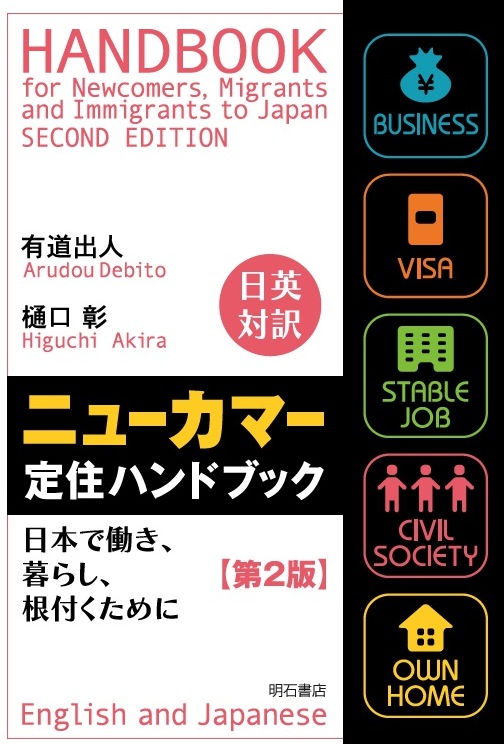mytest
Books, eBooks, and more from Debito Arudou, Ph.D. (click on icon):





![]()


UPDATES ON TWITTER: arudoudebito
DEBITO.ORG PODCASTS on iTunes, subscribe free
“LIKE” US on Facebook at http://www.facebook.com/debitoorg
https://www.facebook.com/embeddedrcsmJapan
http://www.facebook.com/handbookimmigrants
https://www.facebook.com/JapaneseOnlyTheBook
https://www.facebook.com/BookInAppropriate
Hi Blog. Here’s my latest column. Enjoy. Debito Arudou, Ph.D.
//////////////////////////////////////////////////////////
CULTURAL EDUCATION MUST BE DONE MINDFULLY
Japan’s internationalization is inevitable. So is teaching Japan’s future generations of diversity. If done wrong, educating about Japanese culture and society could do more harm than good.
By Debito Arudou, Ph.D., SNA Visible Minorities column 49, Sept 25, 2023
Like it or not, Japan’s internationalization is happening. There are fewer Japanese and more foreigners than ever. In 2022, the population of Japanese citizens dropped below the 125 million mark for the first time in Japan’s modern era, while the registered Non-Japanese (NJ) population reached a record high at over 3 million, or 2.4% of the total population.
That can only grow. Even if the NJ population numerically stayed the same as it is now, its percentage of the total population will still rise due to Japan’s below-replacement birthrates. But the NJ population will not stay the same — the economics of Japan’s aging labor force is reaching the point where officials see the writing on the wall. According to a recent Kyodo News survey, a whopping 86% of Japan’s municipalities want more NJ workers to do the jobs and save their senescent cities from extinction.
All of these figures do not, of course, include all the multicultural and multiethnic children already in Japan with diverse identities and backgrounds — routinely ignored because Japan’s Census does not measure for ethnicity. So if anything, Japan’s internationalization is grossly underestimated.
TEACH THE CHILDREN WELL
The front line of this trend is Japan’s education system, where the children of immigrants make an immediate and urgent impact on society. This is not news. For more than a quarter century, local governments have begged for enhanced services to help their residents with language and acculturation barriers assimilate into their schools and communities. The national government has basically ignored them.
But we are seeing some progress. Multilingual manuals about local customs and rules have long been issued by governments and civil society, including some helpful training videos to help explain elementary school rules and cultural practices in simpler Japanese. A good example was produced by students at Wakayama University and featured in the Mainichi last year.
This is highly laudable. But a point of caution: This isn’t just a matter of telling all Newcomers to “Do as the Romans do.” Without mindful production of teaching materials grounded in solid social science, cultural education could have the opposite effect: Solidifying stereotypes, entrenching prejudice, and making the perceived newcomer feel like a perpetually subordinated outsider.
Consider some bad habits that are the default mode:
One is systemic — the tendency towards stereotyping within language teaching itself. I recall my French language textbooks introducing “French things” (petit pan, grande pan, etc.) as something all French people ate. No mention, say, of couscous, or other ethnic but Francophone cuisines. Or for that matter of other Francophone people. All French people in my textbooks were white, which simply didn’t reflect reality.
To the untrained eye, that meant that whatever doesn’t fit a textbook image of “Frenchness” wasn’t seen as “French.” It put up artificial walls between peoples simply out of habit or convenience. That’s because basic language training necessarily tends to overgeneralize about societies and boil them down to foundational language. But resorting to prototype omits developments in society, such as cultural diversity from international migration.
That’s why we need trained eyes to avoids stereotyping. Let social scientists, not just linguists or untrained do-gooders, also have input into the learning process.
But there are also some bad habits that are intrinsic to Japan, easily seen when even the most educated people teach Japanese culture…
BEWARE “UNIQUE JAPAN”
Consider the narrative focus on “Japanese uniqueness,” as in, “only Japan has this,” for just about anything worthy of portraying as “Japanese.” For example, I’ve seen educational materials claiming that enjoying four seasons and eating octopus are “uniquely Japanese.”. Calamari, anyone?
One problem with the “uniqueness trope” is that it prioritizes differences over similarities. This is the natural outcome of humanities as a field seeing culture as a constellation of contrasts. Anything not remarkable or dramatic enough to cause “culture shock” doesn’t seem to be all that worthy of study.
Yet no matter what, people are far more similar than they are different (start with the fact that we are carbon-based mammals and work up). And by portraying even the most mundane things (such as using chopsticks, taking off your shoes at the doorway, or sorting your garbage) as some kind of cultural minefield only serves to make study of other societies unduly formidable and anal-retentive.
So focus on practical goals. Give them the right words to accomplish the tasks and things will flow from there.
The other problem with fixating on difference to the point of “uniqueness” is that it encourages ascription and exclusion. Anything deviating from the portrayed image of “Japaneseness” automatically becomes “foreign.”
Consider the political outcomes of this. Let’s say you have a suggestion for how things could be done better, but alas, you’re a foreigner? Too bad. It won’t work in Japan because we are unique and not like any other foreign country and we do things differently. Foreign things must automatically be different or they wouldn’t be foreign.
But what if a Japanese suggests the same thing? Well, we can’t accept that either. Obviously it’s still not the norm, because if it were, you wouldn’t be suggesting a change.
Either way, the door is slammed on social change. Eliminating the possibility of any cultural overlap reinforces the “us versus them” mindset and feeds directly into social othering, all of which are counterproductive to societies evolving.
“WE JAPANESE”
Another problem is portraying Japan as a monolith. Guidebooks on Japan tend to represent it as a one-size-fits-all experience, and that “Japanese behavior” is predictable down to topic sentences without exception: “We Japanese think or behave this way.” Switch on the TV (especially NHK World) and you’ll see that narrative reinforced daily.
That’s just stereotyping all over again, and it ignores all the regional differences that plainly exist once you get to know Japan as individuals, regions, dialects, and local mores.
Whenever I get asked to say something about Japan, especially by people who want to go there and experience it for themselves (which I always heartily encourage), I always add the caveat that, “Your mileage may vary, depending on how you’re perceived.” If I were shorter, darker-haired or -skinned, female or non-binary, younger or older etc., my experience of interactions with Japanese society would differ.
Teaching people about life in Japan has to incorporate the inevitability of diversity and exception. There are just so many Japans out there.
The knock-on ill-effect of portraying all Japanese as being a certain way (including physical appearance) means that those who aren’t are not “real Japanese.”
This feeds directly into teaching the students and future residents of Japan that in the end they don’t really belong here. Even if they learn the rules, they never be part of the group that makes the rules.
Why do you think so few of the Non-Japanese on Caregiver Visas who underwent Japan’s very difficult nursing program stayed on afterwards? Because they were only trained to work, not belong to the guild that trained them, or ever assimilate and become Japanese.
“YOU FOREIGNERS”
One final problem to be aware of is that teachers and students should not assume the mantle of what I call “Cultural Ambassadors.” Being told that “Japan is this way” and “How is it in your society?” As if they as individuals could possibly represent whole societies with any real accuracy. After all, being an ambassador takes very specific training in social science, including diplomacy, cultural representation, negotiation, and conflict resolution.
The problem with untrained “do-gooders” indulging in cultural education, and “culture vultures” trying to be helpful and “taking foreigners under their wing,” is that they’re generally not mindful of what they’re doing. They’re often not trying to be a friend on your terms. They’re often studying you like an animal in a zoo or a protozoan in a Petri dish, treating you like a pet or a means to an end.
How many failed relationships and marriages have resulted from people glomming onto you because they were “Gaijin Groupies”? They liked you as in idea more than you as an individual.
Let’s not let cultural education at the compulsory education level fall into these bad habits.
SO WHAT DO DO?
A lot of the tweaks are simple. Make sure that language generalizing about Japan allows for exceptions. “Some Japanese… most Japanese… almost all Japanese.”
But some educational materials must show some awareness of the politics of inclusivity. Make sure that people of diversity are also included in textbook perceptions of the Self, as a part of Japanese society. That if they learn the rules and assimilate, that they too can have a role in being part of the process of rule creation.
Also, be aware that there are always politics behind any cultural training. Make sure that the “How-Tos” don’t overstep their bounds. Focus on the rules and how to follow them, and avoid going beyond that to demand people give up their power and become obedient “Model Minorities.”
How to do that? See them as individuals here for good trying to learn the ropes. Help them become residents of Japan, if not colleagues and friends. Don’t treat them something temporary, as if they are a rare bird with remarkable plumage that magically alighted on your windowsill, here only for an instant and gone tomorrow.
Simply put, show some real empathy. What would you want to know if you were moving into a new society and trying to fit in? Treat Newcomers and neophytes as you would like to be treated. Sounds obvious to say, but all sorts of bad habits get in the way.
ENDS
======================
Do you like what you read on Debito.org? Want to help keep the archive active and support Debito.org’s activities? Please consider donating a little something. More details here. Or if you prefer something less complicated, just click on an advertisement below.